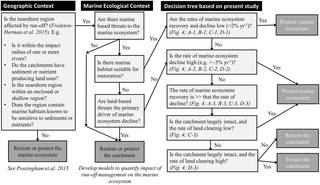PLOS Biology ( IF 7.8 ) Pub Date : 2017-09-06 , DOI: 10.1371/journal.pbio.2001886 Megan I. Saunders , Michael Bode , Scott Atkinson , Carissa J. Klein , Anna Metaxas , Jutta Beher , Maria Beger , Morena Mills , Sylvaine Giakoumi , Vivitskaia Tulloch , Hugh P. Possingham

|
Coastal marine ecosystems can be managed by actions undertaken both on the land and in the ocean. Quantifying and comparing the costs and benefits of actions in both realms is therefore necessary for efficient management. Here, we quantify the link between terrestrial sediment runoff and a downstream coastal marine ecosystem and contrast the cost-effectiveness of marine- and land-based conservation actions. We use a dynamic land- and sea-scape model to determine whether limited funds should be directed to 1 of 4 alternative conservation actions—protection on land, protection in the ocean, restoration on land, or restoration in the ocean—to maximise the extent of light-dependent marine benthic habitats across decadal timescales. We apply the model to a case study for a seagrass meadow in Australia. We find that marine restoration is the most cost-effective action over decadal timescales in this system, based on a conservative estimate of the rate at which seagrass can expand into a new habitat. The optimal decision will vary in different social–ecological contexts, but some basic information can guide optimal investments to counteract land- and ocean-based stressors: (1) marine restoration should be prioritised if the rates of marine ecosystem decline and expansion are similar and low; (2) marine protection should take precedence if the rate of marine ecosystem decline is high or if the adjacent catchment is relatively intact and has a low rate of vegetation decline; (3) land-based actions are optimal when the ratio of marine ecosystem expansion to decline is greater than 1:1.4, with terrestrial restoration typically the most cost-effective action; and (4) land protection should be prioritised if the catchment is relatively intact but the rate of vegetation decline is high. These rules of thumb illustrate how cost-effective conservation outcomes for connected land–ocean systems can proceed without complex modelling.
中文翻译:

简单的规则可以指导陆基或海洋保护将最有利于海洋生态系统
可以通过在陆地和海洋上采取的行动来管理沿海海洋生态系统。因此,有必要量化和比较两个领域中行动的成本和收益,以进行有效的管理。在这里,我们量化了陆地沉积物径流与下游沿海海洋生态系统之间的联系,并对比了海洋和陆地保护行动的成本效益。我们使用动态的陆地和海洋景观模型来确定是否应将有限的资金用于4种替代性保护行动中的1种,即保护陆地,保护海洋,恢复陆地或恢复海洋,以最大程度地扩大保护范围年代际上依赖光的海洋底栖生境的分布。我们将该模型应用于澳大利亚海草草甸的案例研究。我们发现,根据保守估计海草可扩展到新栖息地的速度,在该系统的十年中,海洋恢复是最具成本效益的措施。最佳决策在不同的社会生态环境中会有所不同,但是一些基本信息可以指导最佳投资以抵消陆基和海洋压力源:(1)如果海洋生态系统的下降和扩张速度相似,则应优先进行海洋恢复;低的; (2)如果海洋生态系统下降速度较高或邻近流域相对完好且植被下降速度较低,则应优先考虑海洋保护;(3)当海洋生态系统扩张与衰退的比例大于1:1.4时,基于陆地的行动是最佳的,陆地恢复通常是最具成本效益的行动;(4)集水区相对完好但植被退化率高的,应优先考虑土地保护。这些经验法则说明了在没有复杂模型的情况下如何进行经济高效的保护性陆地海洋系统保护成果。











































 京公网安备 11010802027423号
京公网安备 11010802027423号